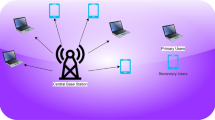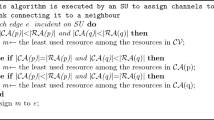Abstract
IEEE 802.11 is one of the most well-established and widely used standard for wireless LAN. Its Medium Access control (MAC) layer assumes that the devices adhere to the standard’s rules and timers to assure fair access and sharing of the medium. However, wireless cards driver flexibility and configurability make it possible for selfish misbehaving nodes to take advantages over the other well-behaving nodes. The existence of selfish nodes degrades the QoS for the other devices in the network and may increase their energy consumption. In this paper we propose a green solution for selfish misbehavior detection in IEEE 802.11-based wireless networks. The proposed scheme works in two phases: Global phase which detects whether the network contains selfish nodes or not, and Local phase which identifies which node or nodes within the network are selfish. Usually, the network must be frequently examined for selfish nodes during its operation since any node may act selfishly. Our solution is green in the sense that it saves the network resources as it avoids wasting the nodes energy by examining all the individual nodes of being selfish when it is not necessary. The proposed detection algorithm is evaluated using extensive OPNET simulations. The results show that the Global network metric clearly indicates the existence of a selfish node while the Local nodes metric successfully identified the selfish node(s). We also provide mathematical analysis for the selfish misbehaving and derived formulas for the successful channel access probability.










Similar content being viewed by others
References
Ieee std 802.11g-2003 (1997). http://standards.ieee.org/findstds/standard/802.11g-2003.html
Bianchi G (2000) Performance analysis of the ieee 802.11 distributed coordination function. IEEE J Sel Areas Commun 18(3):535–547. doi:10.1109/49.840210
Cagalj M, Ganeriwal S, Aad I, Hubaux JP (2004) On cheating in csma/ca ad hoc networks. Tech. rep., Proc. IEEE INFOCOM 2005
Cardenas A, Radosavac S, Baras J (2009) Evaluation of detection algorithms for mac layer misbehavior: Theory and experiments. IEEE/ACM Trans Networking 17(2):605–617
Choi J, Min A, Shin K (2011) A lightweight passive online detection method for pinpointing misbehavior in wlans. IEEE Trans Mob Comput 10(12):1681–1693. doi:10.1109/TMC.2010.262
Deng DJ, Chen HC, Chao HC, Huang YM (2011) A collision alleviation scheme for ieee 802.11 p vanets. Wirel Pers Commun 56(3):371–383
Deng DJ, Ke CH, Chao HC, Huang YM (2010) On delay constrained cac scheme and scheduling policy for cbr traffic in ieee 802.11 e wireless lans. Wirel Commun Mob Comput 10(11):1509–1520
Hayajneh T, Almashaqbeh G, Ullah S, Vasilakos A (2014) A survey of wireless technologies coexistence in wban: analysis and open research issues. Wirel Netw 20(8):2165–2199. doi:10.1007/s11276-014-0736-8
Hayajneh T, Krishnamurthy P, Tipper D, Kim T (2009) Detecting malicious packet dropping in the presence of collisions and channel errors in wireless ad hoc networks. In: IEEE international conference on communications, 2009. ICC ’09, pp. 1–6. doi:10.1109/ICC.2009.5198910
Kim H, Kim H, Park W, Bae M (2013) Disabling misbehavior with traffic constraints in wlans. The Computer Journal. doi:10.1093/comjnl/bxt121
Konorski J (2001) Protection of fairness for multimedia traffic streams in a non-cooperative wireless lan setting. In: van Sinderen M, Nieuwenhuis L (eds) Protocols for Multimedia Systems. Lecture Notes in Computer Science, vol 2213. Springer, Berlin Heidelberg, pp 116–129. doi:10.1007/3-540-45481-0_10
Konorski J (2002) Multiple access in ad-hoc wireless lans with noncooperative stations. In: Gregori E, Conti M, Campbell A, Omidyar G, Zukerman M (eds) NETWORKING 2002: Networking Technologies, Services, and Protocols; Performance of Computer and Communication Networks; Mobile and Wireless Communications, Lecture Notes in Computer Science vol. 2345, pp. 1141–11466. doi:10.1007/3-540-47906-6_98
Kyasanur P, Vaidya N (2003) Detection and handling of mac layer misbehavior in wireless networks. In: Proceedings of the 2003 international conference on dependable systems and networks, 2003. pp 173–182. doi:10.1109/DSN.2003.1209928
Kyasanur P, Vaidya N (2005) Selfish mac layer misbehavior in wireless networks. IEEE Trans Mob Comput 4(5):502–516. doi:10.1109/TMC.2005.71
Li M, Salinas S, Li P, Sun J, Huang X (2014) Mac-layer selfish misbehavior in ieee 802.11 ad hoc networks: Detection and defense. IEEE Trans Mob Comput PP(99):1–1. doi:10.1109/TMC.2014.2348560
Lopez Toledo A, Wang X (2007) A robust kolmogorov-smirnov detector for misbehavior in ieee 802.11 dcf. In: IEEE international conference on communications, 2007, ICC ’07, pp 1564–1569. doi:10.1109/ICC.2007.262
Paul U, Kashyap A, Maheshwari R, Das S (2013) Passive measurement of interference in wifi networks with application in misbehavior detection. IEEE Trans Mob Comput 12(3):434–446. doi:10.1109/TMC.2011.259
Pelechrinis K, Yan G, Eidenbenz S, Krishnamurthy S (2009) Detecting selfish exploitation of carrier sensing in 802.11 networks. In: INFOCOM 2009, IEEE, pp 657–665
Pelechrinis K, Yan G, Eidenbenz S, Krishnamurthy S (2012) Detection of selfish manipulation of carrier sensing in 802.11 networks. IEEE Trans Mob Comput 11(7):1086–1101. doi:10.1109/TMC.2011.131
Radosavac S, Baras JS, Koutsopoulos I (2005) A framework for mac protocol misbehavior detection in wireless networks. In: Proceedings of the 4th ACM workshop on wireless security, WiSe ’05. ACM, New York, NY, USA, pp 33–42. doi:10.1145/1080793.1080801
Radosavac S, Moustakides G, Baras JS, Koutsopoulos I (2008) An analytic framework for modeling and detecting access layer misbehavior in wireless networks. ACM Trans Inf Syst Secur 11(4):19:1–19:28. doi:10.1145/1380564.1380567
Raya M, Aad I, Hubaux JP, El Fawal A (2006) Domino: Detecting mac layer greedy behavior in ieee 802.11 hotspots. IEEE Trans Mob Comput 5(12):1691–1705. doi:10.1109/TMC.2006.183
Raya M, Hubaux JP, Aad I (2004) Domino: A system to detect greedy behavior in ieee 802.11 hotspots. In: Proceedings of the 2nd international conference on mobile systems, applications, and services, MobiSys ’04. ACM, New York, NY, pp. 84–97. doi:10.1145/990064.990077
Rong Y, Lee SK, Choi HA (2006) Detecting stations cheating on backoff rules in 802.11 networks using sequential analysis. In: Proceedings of the 25th IEEE international conference on computer communications, INFOCOM 2006. pp 1–13. doi:10.1109/INFOCOM.2006.305
Shi F, Baek J, Song J, Liu W (2013) A novel scheme to prevent mac layer misbehavior in ieee 802.11 ad hoc networks. Telecommun Syst 52(4):2397–2406. doi:10.1007/s11235-011-9552-y
Szott S (2014) Selfish insider attacks in ieee 802.11s wireless mesh networks. IEEE Commun Mag 52(6):227–233. doi:10.1109/MCOM.2014.6829968
Tang J, Cheng Y, Zhuang W (2011) An analytical approach to real-time misbehavior detection in ieee 802.11 based wireless networks. In: Proceedings of the IEEE INFOCOM, 2011. pp 1638–1646. doi:10.1109/INFCOM.2011.5934957
Tang J, Cheng Y, Zhuang W (2014) Real-time misbehavior detection in ieee 802.11-based wireless networks: An analytical approach. IEEE Trans Mob Comput 13(1):146–158. doi:10.1109/TMC.2012.227
Toledo A, Wang X (2007) Robust detection of selfish misbehavior in wireless networks. IEEE J Sel Areas Commun 25(6):1124–1134. doi:10.1109/JSAC.2007.070807
Wang X, Vasilakos AV, Chen M, Liu Y, Kwon TT (2012) A survey of green mobile networks: Opportunities and challenges. Mob Netw Appl 17(1):4–20. doi:10.1007/s11036-011-0316-4
Yu C M, Chen C Y, Chao H C (2015) Proof of ownership in deduplicated cloud storage with mobile device efficiency. Network, IEEE 29(2):51–55
Author information
Authors and Affiliations
Corresponding author
Rights and permissions
About this article
Cite this article
Hayajneh, T., Almashaqbeh, G. & Ullah, S. A Green Approach for Selfish Misbehavior Detection in 802.11-Based Wireless Networks. Mobile Netw Appl 20, 623–635 (2015). https://doi.org/10.1007/s11036-015-0605-4
Published:
Issue Date:
DOI: https://doi.org/10.1007/s11036-015-0605-4




